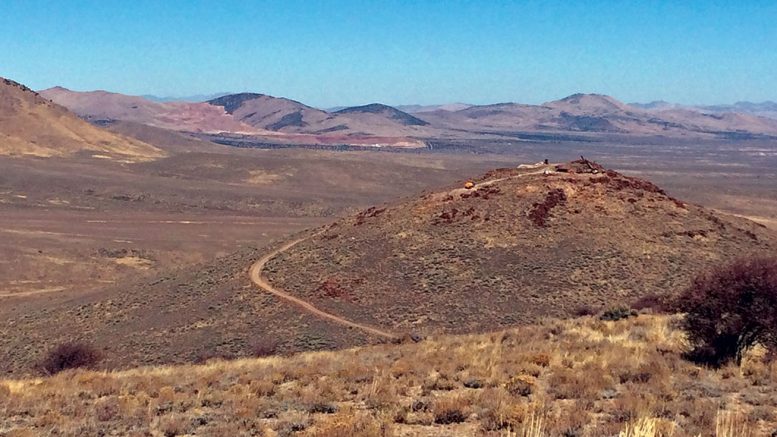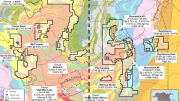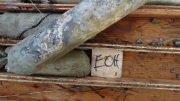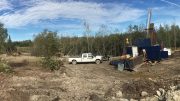Gold Standard Ventures (TSX: GSV; NYSE-AM: GSV) is spending US$15.5 million this year on a 48,800-metre program of core and reverse-circulation drill holes at its Railroad-Pinion gold project in Nevada’s Carlin trend, and the program is delivering encouraging results.
Scout holes drilled north and northwest of the main zone at its North Bullion deposit have uncovered a gold zone that the company says shows that the mineralization at the deposit “has considerable room to grow.”
Core hole 17-6 was drilled 375 metres northwest of North Bullion’s closest mineralized drill hole and found a gold zone outside of the deposit’s maiden resource boundary. The hole returned a 41.7-metre intercept grading 1.91 grams gold per tonne and included a higher-grade, 7.6-metre interval of 6.32 grams gold. The hole was designed to test a west- to northwest-striking trend of higher-grade gold mineralization in a new structural block, and the intercept is open in all directions.
“The fact that we can step out 375 metres on trend into a new fault block and hit high-grade gold beneath post-mineral volcanic cover demonstrates the discovery potential we have at Railroad-Pinion,” vice-president of exploration Mac Jackson says in an interview, adding that there is untested potential in the area around North Bullion, where the company has a lot of targets.
“A 375-metre step-out in the Carlin system is quite a long distance, and at that point we’re really into another hydrothermal cell,” he continues. “Any time you can get to work on something like this with widespread targets and a large system all over the place it’s great. It’s more the case in a project like this of looking for that needle in the haystack. There’s a lot of smoke, and a lot of altered rock everywhere, and it’s all about finding the structural and host setting that’s going to focus the gold system.”
In September, the company reported an indicated resource at North Bullion of 2.92 million tonnes grading 0.96 gram gold per tonne for 90,100 contained oz. gold, and an inferred resource of 10.97 million tonnes grading 2.28 grams gold for 805,800 oz. gold.
The resource estimate uses a cut-off grade of 0.14 gram gold for near-surface oxide and 1.25 grams gold to 2.25 grams gold for near-surface sulphide and underground sulphide.

Drill rigs at the Pinion project in Nevada during the 2015 exploration campaign. Credit: Gold Standard Ventures.
Gold Standard is drilling 6,700 metres this year at North Bullion, a classic Carlin-style, high-grade collapse breccia-hosted deposit. The drill program consists of reverse-circulation (RC) and core holes. RC rigs are used to drill and case holes to depths above the target, and core rigs complete the holes through the mineralized zone.
The company has consolidated ground at the southern end of Nevada’s Carlin trend since 2009, and its 208 sq. km contiguous land package at Railroad-Pinion is the second largest on the gold-rich trend.
Seven kilometres south of North Bullion is the company’s Pinion deposit, which has an indicated resource of 31.6 million tonnes grading 0.62 gram gold for 630,300 contained oz. gold and an inferred resource of 61.1 million tonnes grading 0.55 gram gold for 1.08 million oz. gold, using a cut-off grade of 0.14 gram gold. Infill drill results from 11 holes at Pinion released on Nov. 21 include 56 metres of 1.68 grams gold, 43 metres of 1.23 grams gold and 15 metres of 1.66 grams gold.
About 2 km east of Pinion is Gold Standard’s Dark Star deposit. Dark Star has an indicated resource of 15.38 million tonnes grading 0.54 gram gold for 265,100 contained oz. gold. Inferred resources add 17.1 million tonnes grading 1.31 grams gold for 715,800 contained oz. gold using a cut-off grade of 0.2 gram gold.
“An oxide deposit of that calibre is rare,” Jackson says of Dark Star. “It’s +1 gram and shallow, and that was the sort of deposit mined on the Carlin trend in the 1980s. They’re rare, offer a higher rate of return and the strike length of the Dark Star corridor is 12.5 km … there’s lots of alteration and we’re going to find other deposits out in that corridor. That one is our highest priority, but we’ve got a lot going on, and North Bullion is also great. We like them all.”
In November, the company reported several drill results from its 2017 program at Dark Star, including a 36-metre intercept grading 2.67 grams gold in infill core hole 17-20. The hole was 30 metres north of a drill hole 16-3B (101.2 metres of 1.54 grams gold disclosed on April 18) and 90 metres south of 16-8 (126.2 metres of 4.07 grams gold, also reported on April 18).
Reverse-circulation exploration holes have extended the deposit east and west, as well as 45 metres deeper than the current resource model. Drill hole 17-27 ended in 2.19 grams gold at 183 metres deep, which the company says “may reflect the occurrence of previously unknown deeper horizons of better-grade oxide material, which could have implications for the deposit as a whole.”
The company says the results will improve the grade of the current block model in the northern part of the deposit. CEO Jonathan Awde said in a press release that Dark Star “continues to surprise us to the upside,” and noted that the deposit “is going to look very different at the end of this program than it did a year ago.”

Drilling at the Dark Star target on the Pinion-Railroad property in Nevada. Credit: Gold Standard Ventures.
Gold Standard says its drill program this year “will provide further evidence that the Dark Star and Pinion deposits merge into one larger deposit.”
Metallurgical results in October from column testing for gold-cyanide leachability of Dark Star have also been positive. Forty drill core samples were column tested. All of the samples were crushed to reduce 80% of the material to a size of 12.5 mm or less. Gold extraction for oxide material ranged from 66–95%, with an average gold extraction of 86.5%. Gold extraction from transitional material ranged from 58–90%, with an average 70% gold extraction.
Meanwhile, Gold Standard continues to explore at its Jasperoid Wash and Dixie targets south of Dark Star, where the company has intersected shallow, Dark Star-like gold zones that remain open.
Major shareholders include Goldcorp (TSX: G; NYSE: GG), which has a 9.9% stake, and OceanaGold (TSX: OGC), which owns 15.8%.
The company’s shares are trading at $1.88 apiece within a 52-week trading range of $1.61 (November 2017) to $3.85 (February 2017).
The junior has 233.5 million shares outstanding for a $439-million market capitalization.






IMO Gsv is a most credible 3-5 moz future miner. ….what will be the next catalyst?